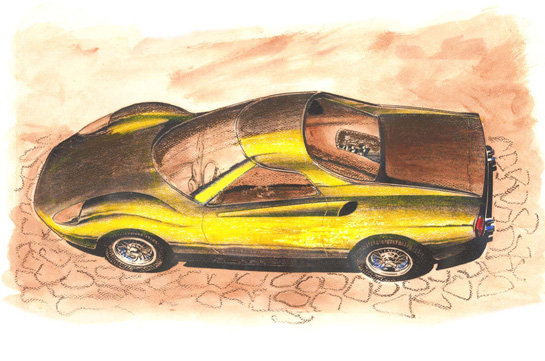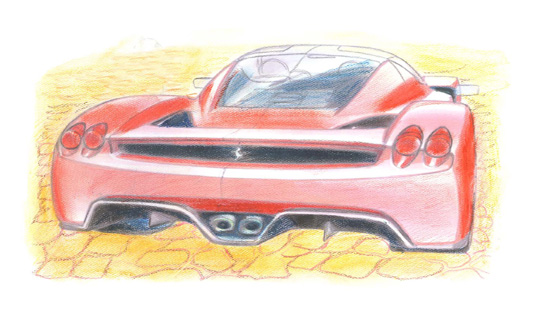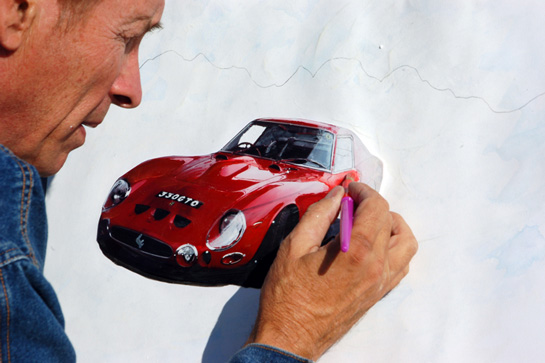
I don't know who did the original Pininfarina Dino road car prototype drawing, maybe Pietro Brovarone? Of course, the first production 206GT road car had quite a few differences, but this was probably done after the Plexiglas- nosed four headlamp prototype. I like to find references to the designs early in the game so you can see how the designs developed.
By Brian Winer
Wallace A. Wyss is known to most sports car folks as a writer and author (with ten car history books to his credit), but in 2007 he re-discovered a long dormant talent for putting a brush to canvas and has since painted over 50 portraits of Ferraris. Brian Winer, Boston-born free lance writer and art connoisseur, interviewed Wyss to ask him what fascinates him so much about the prancing horse.
Winer: Did you have art training?
Wyss: Not really, I graduated with a degree in journalism. I wanted to be an artist but, when an ad agency called while I was still in college and said we have two jobs for interns, one for art and one for copywriting, I applied for Art only to be told that the Art Director position was filled, so I said, “OK I’m a copywriter.” That led to a job at Campbell Ewald on the Chevrolet account and eventually to me leaving for California to work on car magazines.
Winer: So how did you pick up art again?
Wyss: Scroll down 40 years and I am publicizing my book on Shelby called “SHELBY: The Man The Cars The Legend.” After I sold the book to a magazine publisher, I asked him if he wanted to see the portrait of Shelby I had done specifically to promote the book. I showed him a snapshot. He said, “Where is it?” and I said, “In my car.” He said “Go get it, you sold that too.” During the long walk to the car I figured I should start painting again. This time I found someone that can make prints of my originals so I was able to expand the audience for the work.
Winer: Where do you do your painting?
Wyss: I don’t have a studio as such. If I have time I’ll go up to the mountains when I am in Southern California and bring my working surface and paints with me. When I am up North, I have an old cabin on my family’s homesteaded ranch in Mendocino where no one disturbs me.
Winer: So what cars do you prefer to depict most?
Wyss: I prefer Ferraris and Cobras. Cobras, because I have done three books on Shelby and his cars and it ties in so well when I am selling my Cobra and Shelby books. With Ferraris, I am always drawn to the dramatic shapes and exotic engines of Ferraris whether new models or old classics. I have a new book coming out, a novel set in the world of Ferrari collectors, so there’s inspiration there to do more Ferraris, maybe ones mentioned in the book.
Winer: What was your first encounter with Ferrari?
Wyss: The very first exposure occurred back when I was about ten years old, in the form of the Fuller Brush catalog which had a story by Denise McCluggage on Phil Hill, with lots of color on Testa Rossas, etc. I grew up in Detroit and had never heard of Ferrari until I saw that catalog. You can bet I paid more attention to the Fuller Brush man after that. But, it wasn’t until Pete Vack discovered the connection between Fuller and Ferraris that I found out why that article was published. (See article)
Winer: Did you own any?
Wyss: Only two, a ’71 GTC/4 and a 308 GTS. I actually bought the 308 new but sold it after I decided I wanted the sound of a V12. I bought the C4 for $10,000 less than I sold the 308 for. I’m not counting the Ferraris I bought and sold as a Ferrari hunter in the late 1980s.
Winer: What others have you had a personal association with?
Wyss: I prefer to paint a picture of a car I have ridden in, such as the Ferrari Breadvan, the twin nostril 250GT by Giugiaro, the Lusso, the Daytona, the short wheelbase 250GT and so forth.
Winer: How did you get a ride in these cars?
Wyss: I worked for Motor Trend in the early ’70s. They had an associate art director who was just batty about Ferraris, named Chuck Queener. I’d watch him paint cars and then also occasionally go on rides in cars he was fiddling with, one a GTO that he had borrowed for a week and another time a 275GTB that had been abandoned by a rock musician. Another time I assisted a photographer who had a photo assignment to shoot Ferraris for Automobile Quarterly so I photographed and rode in several just at the time collectors were starting to notice the rise in their value. Also I joined the Ferrari Owner’s Club and used to sneak out Detroit musclecars from the Motor Trend garage, like the Pontiac Trans Am, to go along on their runs, trying to keep up with them as they would tear around Malibu’s back roads but the musclecars always overheated or ran out of brakes. That’s when I became a staunch believer in Ferrari.
Winer: We find it incredible that multimillion dollar cars were driven on club events on the street.
Wyss: Yes, it had to do with pizazz. I suspect that the show biz people were using the exotic cars to show off. Sonny and Cher, for instance, had a 250LM. Dino Martin had some kind of mid-engined Ferrari prototype, maybe a P3/4, in fly yellow of course, and Phil Spector reportedly made the scene in his Cobra Daytona coupe. At Motor Trend, I worked in the Petersen building on Sunset Strip so got to see lots of oddball cars go by every time I went out to lunch. There was a used car lot across the street and all sorts of fancy cars would pop up there. I even remember a Chevy-engined Vignale bodied Ferrari and a racing Iso Grifo A3/C for sale and the time someone tried to sell the car lot a one off Tjaarda-designed Pininfarina-bodied Mercedes 230SL. Every once in a while I’d try to buy a car from the lot but was always a day late and a dollar short–I never thought they would go up so high, like the time in 1969 when I turned down a 250GTO offered by Henry Manney III (R & T writer–Ed.) for I think $18,000 or $19,000!

This Enzo drawing is pretty close to what Ken Okuyama did for Pininfarina. Ferrari actually handed out posters carrying his signature at the preview but you had to be right there on the unveiling to get one. This one is in pastels.
Winer: What media do you use?
Wyss: I started with watercolors, got dissatisfied, went to acrylic oils which work like watercolors when thinned out and like regular oils when unthinned, and then I went to full oils and am now experimenting with pastels. I am also thinking of stainless steel sculpture.
Winer: What’s the inspiration for each work?
Wyss: I have a 10,000 picture library, a good many of which I took myself while globe trotting in the ’80s. Sometimes I choose one of my own but other times I will be inspired by another photo and I reinterpret it according to the style I am doing at the time.
Winer: What artists do you like?
Wyss: In fine art painting, Edward Hopper and Thomas Hart Benton, but in automotive art
Ken Dallison and Dennis Brown are my favorites but I can’t match their style, though I did once sit next to Dallison for an entire day while he painted illustrations for a Corvette Catalog that I was writing for Chevy’s ad agency and learned his painting secrets.
Winer: What about those design renderings you did?
Wyss: That’s something new I am experimenting with to see if there’s any interest. Of course there are design renderings done by Ferrari since the first road car but even when a new model comes out they only release two or three renderings, usually for the specialized magazines. I thought I would pick the drawings I like and re-interpret them. So far I’ve only done the Dino 206GT prototype, the Enzo and the 599 SA Aperta. I’m afraid that when computer design completely takes over, these renderings will be rendered to history.
Winer: How big are your works in the original?
Wyss: Sometimes very small, maybe 12″ x 18″ I can’t see as well as I used to. But on the portraits of race drivers I went up to 22″ x 33″ on canvas. I normally print only on 80-lb. watercolor paper, and someone would have to order it special for me to print on canvas, which is called a “giclee” (pronounced GHEE CLAY–Ed.).
Winer: Where are you headed with your Ferrari Art?
Wyss: Aside from doing a few movie poster style GTO paintings for my novel, I always wanted to emulate the style of the artist that did paintings for the old Supercar Classics magazine that had drawings of engines and mechanical bits with little hand-written notes all over the painting. I might try one of those if I can find an engine that is sufficiently intriguing, probably a six carb GTO engine. I am fascinated with handwriting and want to incorporate that into a painting mainly because now that we are in the computer age I kind of miss good old handwriting.
Winer: We notice you say your prints are signed and numbered. What’s the difference between those and prints without those two features?
Wyss: Well, to me, an unnumbered print is just a mass-produced item with the artist having no control over how it was printed or how many. When it’s hand-signed, though, the artist has the opportunity to reject it before it goes out. The numbering is for limited editions where you say, for instance, with a number like 17/500 that what you’re looking at the 17th print out of only 500 printed in that particular size or in that particular run.

If I have a photograph I took where the car is rare, say like the 330GTO--where I like the car but hate the background--I think that one had various transport rigs in back of it-- I paint the car first and then look later for a background I like to set the car into later. This one is mixed media, including acrylic oils, and I intend to go for a photorealism style but may go softer on the car if the background ends up softer, so there's not too sharp a contrast.
Winer: What else are you doing besides artwork?
Wyss: I’m still a reporter and looking forward to Monterey. I’m just about finished editing the novel I call the “first Ferrari detective novel” because it’s about a private investigator who is buying and selling Ferraris while solving murders. I am seriously thinking of using my side view painting of a 250GTO on the cover but of course if a publisher buys the manuscript they will be deciding what goes on the cover.
Winer: Where can we find your art work?

The designer of the Dino 206/246 GT/GTS (included prototypes) is Aldo Brovarone.
Regards,
Pierre Goossens, Mignault (Belgium)
I was going to correct the mis-spelt name too, but also add that Leonardo Fioravanti has also been credited with the Dino road car design, something he himself does not dispute…
The most familiar Dino road car prototype is the 206 S Dino Berlinetta Competizione, SN 034 a design by Paolo Martin, who previously worked for Michelotti and Bertone. That car was similar to the one illustrated here except for gull-wing doors and spoilers front and rear. Brovaone is credited with the red berlinetta Ferrari Dino shown in 1965 on the Pininfarina stand at Parigi, which had four headlamps under plexiglass in the leading edge of the car rather than headlamps in the fenders. This design study was set on the non-running chassis 0840 which also has non circular taillights hinted at in the drawing. I found a website with Brovaone’s drawing of this car http://www.conceptcars.it/stilisti/brovarone.htm which interestingly shows an alternate and more practical front end treatment. Sometime if there’s any interest in the prints, I will do drawings of some of the variations on the mid-engined Dino leading up to the production car.
Leonardo worked there starting in ’64 so he was there at the right time and I can find his name attached to the Dino 206GT but I think the Brovaone drawing
http://www.conceptcars.it/stilisti/brovarone.htm
shows more the same style as the one I have newly re-created. Besides I think Leonardo would be happy enough being credited with the Ferrari Daytona, Ferrari P5, Ferrari P6, Ferrari 512 Berlinetta Boxer, 365 GT4 2+2, la Ferrari 308 GTB, and 288 GTO
The gentleman Mr. Wyss refers to as the artist in Supercar Classics depicting subjects of technical nature with hand written notes is Robert Freeman, who tragically passed away by his own hand some years ago. Check out his web site: http://www.robertfreeman.com to see some of his works. I remember reading him say that his teachers were always impressing him to “master his circles”. I’d say he did that and then some.
Tom Ward
Ahem…………….make that bobfreeman.co.uk
Judging from the tire edge details and the same detail used on a rendering of the 1961 Ferrari 40o Super America, signed by Aldo Brovarone, I would say that he drew the above rendering.
I had the opportunity to design for both Aldo Brovarone, the design director for PF and Leonardo Fioravanti, head of Centro Studi & Ricerche while I was there in 1980. I must say it was a great experience working for both of them along with the other designers in the studio!
Robert Freeman was trying for something in art that was as brave as
Ralph Steadman does; doing his own thing different from everyone else and in doing so; trying to find an audience. I think a couple of times he was in CAR magazine but Supercar Classics, alas, whose editors were his biggest fans, did not make it. Steadman on the other hand, vaulted to fame with political cartoons , combining efforts with Hunter Thompson, and his career lives on despite the death of his writing collaborator. If only Freeman had been discovered by a wider audience in time, in my humble opinion, he might have been less likely to reach the end he did. If anybody out there gets a chance to buy an old Supercar Classics with his work, it’s worth framing….
Hey, Wally, remember me? From way back in DTW, Fla and LA? Congrats on your movie deal and the newly discovered talent in art. I always knew you had it in you! I’m in San Diego now for the winter, but in March I’ll be back to the Fatherland, in my hometown Bonn, just 20 mi from the Nuerburgring, to spend the summer. Come see me there sometime. If the movie people need a guy in any function who knows the European endurance races, tracks, drivers of the era, have them contact me.
Wally did a feature R-T article on my Ferrari 250 LWB California Spyder w/o covered headlights.
Remember WW?
All the best,
Paul
Dear Gero Hoschek
Well first off thank you soo much for teaching me how to use tools. And for pushing me so hard when i was young. It made me so strong as i grew up. I miss you so much. I now live in germany and going to get married to a wonderful german lady.
Best wishes Oliver Stephan Hoschek
I am looking for Gero Hoschek,
does anybody hava contact to him? My parents know him from Bonn / Germany as they were students. During the last month they talked about him and his sister Gisela. It would be nice if somebody could help me to find him or Gero, if you will read this note, please contact me.
Thanks a lot.
Best regrads from Berlin
Soha Asgari